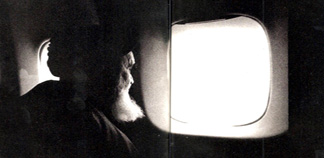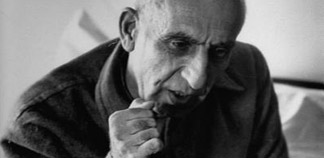به زبان فارسی
PICTORY
LATEST MUSIC
SEARCH
ALLEGORY
10-Feb-2009 (12 comments)
Here is a quiz question: - If I were to ask you to identify one single style of narrative that has consistently existed in our Iranian Art and literature for several millennium what would you say it is? OK, I’ll give you a clue, what do writers and Artists do under repression and censorship? The answer is they use allegory. More consistently for the last 1400 years, these allegories are signs of how as a nation we have taken bends and twists to comply, shape or live with Islamic law or live under tyranny of kings, sheikhs, Sultans and Khans and say what we want to say>>>
EXCERPT
09-Feb-2009 (8 comments)
ABU JAFAR AL-MANSUR was taking no chances with his new imperial capital, for this was to be a city like no other. The second Abbasid caliph of the Muslims turned for guidance to his trusted royal astrologers, the former Zoroastrian Nawbakht and Mashallah, a Jew turned Muslim from Basra and now ``the leading person for the science of judgments of the stars.'' The pair consulted the heavens and declared that July 30, 762, would certainly be the most auspicious day for work to begin. Still, al-Mansur hesitated. He ordered his architects to mark the layout of the walls of his proposed city – a perfect circle, in keeping with the geometric teachings of the caliph's beloved Euclid – on the ground, first in ashes and then again with cotton seeds soaked in naphtha>>>
HERITAGE
09-Feb-2009 (one comment)
It is dark and quiet in the plane. We are descending towards Philadelphia. Our sad journey began at nine this morning and probably will not end until eleven tonight. But, that is the easy part. The hard part is to enter the house on Rexford Rd. How can we step into your house Ezat Jon knowing that you will not be there to greet us with your cheerful, kind, and lively face, and your traditional three kisses on the cheek? How can we enter the house without your friendly smile and big welcome? My heart is aching for the good old days when the house was filled with life, warmth, laughter, and love>>>
VIEW
02-Feb-2009 (41 comments)
A common narrative concerning the Shah and the Pahlavi legacy unites much of Iran’s intelligentsia with liberal-left opinion in the West. According to this narrative, Mohammad Reza Shah’s father, Reza Shah, was an absolutist dictator who attempted to modernize Iran at the point of the gun and an entirely unacceptable pace. Meanwhile, Mohammad Reza Pahlavi is depicted as a corrupt stooge and a “westoxicated” lapdog of American imperialism who, by squashing the authentic democratic urges of his people, ultimately empowered the fundamentalist scourge now raging in his homeland. As the 30th anniversary of the late Shah’s departure from Iran approached, I had the opportunity to read Gholam Reza Afkhami’s magisterial biography of Mohammad Reza Pahlavi>>>
WHAT?
25-Jan-2009 (12 comments)
Regardless of whether there is any political meaning behind the news of the Persian use of chemical warfare and the current controversy regarding “weapons of mass destruction”, it is still interesting to see whether this new piece of research has any scientific value. For this, we turned to a colleague, Mr. Reza Yeganehshakib, who is a PhD student at the department of history, University of California, Irvine. Mr. Yeganehshakib comes to UCI with previous degrees in Chemical Engineering (BS) and Environmental Studies (MS). He has a strong understanding of the scientific processes that might have resulted in what has been reported in the news bit above. The following are his comments>>>
OPPOSITION
16-Jan-2009 (7 comments)
In 1941, after the forceful abdication of Reza Shah, the angry British government, who saw Reza as a former ally turned into a treacherous enemy, seriously considered the restoration of Qajar dynasty. However, the lead Iranian intellectuals (like Foroughi) could only foresee a major political upheaval, with the return of arrogant Qajars. Although Foroughi was persecuted by Reza Shah, he reasoned that the country had truly democratic laws (constitution) and if the Pahlavi crown prince was ready to respect them, there was no reason for a regime change. That way, Mohammad Reza Shah came to be the new constitutional monarch of Iran, who for nearly a decade respected the democratic institutions of the country. >>>
BEAUTIFUL
13-Jan-2009 (7 comments)
Richard Lucas has a dream. He would like to see a statue of Voytek, the Iranian Soldier–Bear of Monte Cassino, built in Iran. And the successful British entrepreneur, based in Krakow, is doing everything he can to make the dream become reality. The story of Voytek the 6-foot, brown Iranian bear, who marched in rank, drank beer, wrestled with his fellow soldiers and distinguished himself during one of the bloodiest battles of World War II, is one of the most remarkable stories in military History. Found orphaned in 1942 on the road between Hamadan and Kangavar, the baby bear was adopted by Polish soldiers and taken away with them to Lebanon the join the Allied 8th Army>>>
REZA SHAH
09-Jan-2009 (39 comments)
Reza Shah truly instigated the wide ranging modernization of Iran from a filthy, backward and lawless shell-of-an-state, to a functioning and advancing society. With the new roads and trucks, the all too frequent famines of the earlier twentieth century disappeared. Under the new army’s watchful eyes, bandits and tribes could no longer rob the caravans or invade towns and villages. The new schools and colleges gave hope and purpose to many youths for a better future and the flourishing of their talents. Emancipation of women encouraged that half of the population to play a more active role in public life. Municipal modernizations, public health initiatives and vaccinations, lowered the infant and general mortality rates and provided a brighter outlook for young families. >>>
NUCLEAR
06-Jan-2009 (7 comments)
The Iranian nuclear enrichment program and its potential to create weapon- grade uranium that could be used for making bombs is the hottest topic of discussion among the western powers and international community. In order to better understand Iran’s intention, one must look back to its origin and study the history behind its current activities. Iran’s ambitious plan to acquire nuclear power is nothing new and dates back to the late Shah of Iran. It was his government’s desire to acquire the nuclear technology of the present time. During the past several years, a number of misguided attempts have been made to uncover the truth behind Iran’s nuclear activities>>>
QAJARS
20-Dec-2008 (16 comments)
After Agha Mohammad fell, his army disintegrated and several months of infighting followed among the Qajar princes. Finally, his nephew was crowned as Fatah-Ali Shah, in 1798, whose only Fatah (victory) was over several hundred wives and concubines. The 35 years of Fatah-Ali Shah’s reign witnessed a gradual decline of Qajar dynasty, who started the nineteenth century like blood-thirsty wolves, but finished it like frail rats. The crippling blow came in the form of Persian-Russian wars. In 1800, incapable of protecting his people against the Qajar invasions, the king of Georgia simply relinquished his crown to the Tsar of Russia! This initiated 14 years of war that coincided with the Napoleonic wars in Europe>>>
HISTORY
08-Dec-2008 (19 comments)
The new Khan of the united Mongol tribes (Genghis) was rapidly expanding eastward into the Chinese territories, but apparently; he was considering Iran more as a potential trade partner towards Europe, rather than an immediate target. Therefore, Genghis was astonished when the riches of a Mongol caravan were confiscated by the border guards of Iran, and all the 200 merchants and guards were executed. He sent another group of emissaries directly to Khwarizm Shah’s court with a plea for retribution, but they too were killed! In response, the angered Mongol chief sent a massive army of 200,000 murderers into Iran.The first wave of Mongol invasion (1220 to 1224) destroyed most of the Khorasan cities (the cradle of Farsi civilization), killing millions and enslaving millions more! All eastern centers of Iranian culture, agriculture and business were irrevocably destroyed or devastated>>>
HISTORY
01-Dec-2008 (6 comments)
This project started more than a decade ago when I was searching the public libraries for books for children on Iranian culture and history. While there was ample information on many ancient civilizations like Egypt, China, India, Mesopotamia, Greece and Rome, there was virtually nothing to be found on Iran. I was saddened by the lack of material and always dreamed of the day all kinds of books on Iran would be available for all young readers around the world. My dream was realized mainly because of the revolutionary new technology that has emerged with digital photography and new advances in book publishing. Thirty years ago publishing a pictorial history with 264 high quality images would have been the task for professional and established publishers with resources and lots of money>>>
RECENT COMMENTS
IRANIANS OF THE DAY
| Person | About | Day |
|---|---|---|
| نسرین ستوده: زندانی روز | Dec 04 | |
| Saeed Malekpour: Prisoner of the day | Lawyer says death sentence suspended | Dec 03 |
| Majid Tavakoli: Prisoner of the day | Iterview with mother | Dec 02 |
| احسان نراقی: جامعه شناس و نویسنده ۱۳۰۵-۱۳۹۱ | Dec 02 | |
| Nasrin Sotoudeh: Prisoner of the day | 46 days on hunger strike | Dec 01 |
| Nasrin Sotoudeh: Graffiti | In Barcelona | Nov 30 |
| گوهر عشقی: مادر ستار بهشتی | Nov 30 | |
| Abdollah Momeni: Prisoner of the day | Activist denied leave and family visits for 1.5 years | Nov 30 |
| محمد کلالی: یکی از حمله کنندگان به سفارت ایران در برلین | Nov 29 | |
| Habibollah Golparipour: Prisoner of the day | Kurdish Activist on Death Row | Nov 28 |
















